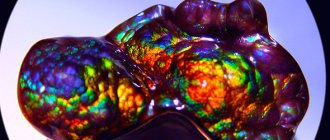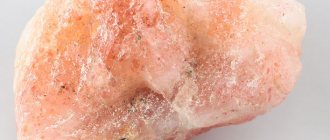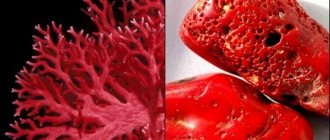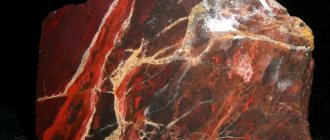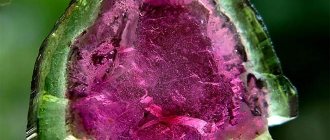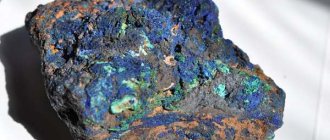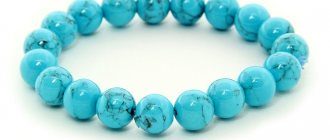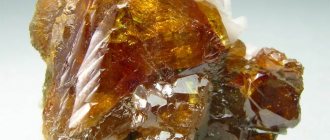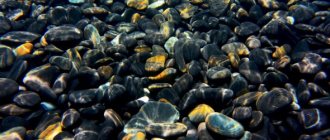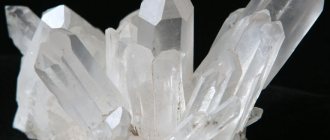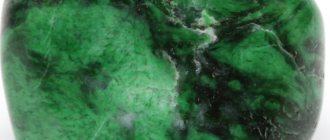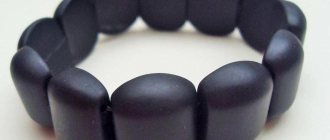It could become a precious stone, but it is better known in narrow circles - mineralogists, collectors. It is very rare to find danburite in jewelry, although its qualities are even superior to topaz and only slightly inferior to diamond.
Beautiful transparent, yellowish and, as a rarity, pinkish or bluish crystals are attractive in their natural form, and after processing they play with all their facets no worse than other semi-precious stones. Why is danburite stone not popular among jewelers?
What is a mineral
Danburite is not without reason nicknamed the Mexican diamond:
- Transparent, with a glassy sheen, the faceted stone is indistinguishable from a diamond.
- Sometimes it looks like tourmaline, citrine, phenacite, apatite.
- Bementite stands out - a transparent variety with needle-shaped fragments of tourmaline inside. Named after the American, collector Spencer Bement.
The first crystals were discovered in 1839 in the vicinity of the city of Danbury (USA, Connecticut) by Charles Shepard, a professional field hockey player and participant in the Olympic Games. The find inscribed his name in the history of mineralogy.
Danburite crystal from Mexico, height 4.5 cm
Storage and care
Earrings with danburite
Danburite has a high hardness level, but also increased fragility. This means that it must be protected from mechanical impact - falling, squeezing, sharp impacts on a hard surface.
Store the mineral separately from other minerals to avoid damage to more fragile stones. To do this, use a box or box with soft upholstered walls or a fabric bag.
In case of contamination, wipe the gem with a soft piece of cloth soaked in soapy water. After this, rinse it with running cool water and immediately wipe it dry.
Danburite is not afraid of the sun; it fluoresces under ultraviolet rays. At the same time, it should be protected from sudden temperature changes.
Physico-chemical characteristics
According to the chemical nomenclature, the mineral danburite is calcium borosilicate. The complexity of the composition is reflected in the long formula CaB2[SiO4]2.
| Formula | Ca[B2Si2O8] or B2O3 CaO 2SiO2 |
| Color | Colorless, wine yellow, pink |
| Stroke color | White |
| Shine | Glass, greasy when broken |
| Transparency | Transparent |
| Hardness | 7 – 7,5 |
| Cleavage | Imperfect |
| Kink | Uneven, conchoidal |
| Density | 3.0 g/cm³ |
| Crystallographic properties | |
| singonia | Rhombic |
| Refractive index | 1,630 – 1,636 |
Place of Birth
In igneous rocks it occurs in the form of single grains, nests and veinlets. Observed in pegmatites in association with clevelandite; in potassium syenites (filling of cracks) - in association with quartz, adularia, amphibole; Danburite crystals were found among chlorite in granites; in greisenized aplite dikes - in association with topaz, tourmaline, cassiterite, and arsenopyrite.
Known in some tourmaline-containing subrare metal pegmatites of Central Transbaikalia, Pamir, Nepal, USA, Czech Republic and in rare metal pegmatites of Madagascar. In drusy parageneses of subrare metal pegmatites of the Malkhan field of Central Transbaikalia, it is one of the common accessory minerals of near-miarole complexes and miarole fill material. In lepidolite-clevelandite complexes (Oreshnaya vein), intergrowths of danburite crystals (up to 0.3 x 1 cm) often cover crystals of polychrome tourmaline. In the near-miarol zones of acid leaching (Oktyabrskaya and Sosedka veins), brushes of numerous crystals (up to (3-4) x 10 mm, rarely 2 x 10 cm) of danburite are overgrown with crystals of quartz, tourmaline and K-feldspars.
In contact-metasomatic deposits, the largest accumulations are confined to calcareous borosilicate skarns associated with the metasomatic replacement of limestones by boron-bearing hydrothermal solutions. At the Dalnegorsk deposit (Primorye) it is developed in the Left Bank area only within the skarn deposit in association with garnet and datolite (early stage of skarnization). The thickness of the danburite zones is 0.5-3.0 m. Datolite metasomatically develops along the danburite. In the late, relatively low-temperature stage, it decomposes with the removal of boron and is replaced by an aggregate of quartz and calcite. In large cavities there are well-developed crystals (up to 40 cm long), which, when superimposed by late skarning processes, are replaced zonally (from the periphery to the center) by garnet, hedenbergite, acanite, quartz, datolite and calcite. Thermobarogeochemical studies showed that the process of formation of pseudomorphs in a danburite crystal began from the periphery of the crystals at temperatures above 350° and ended with the replacement of their central parts at 130-150°; The geochemical evolution of the mineral formation environment was also traced.
According to the results of a study of gas-liquid inclusions in danburite, datolite and associated minerals, the formation of danburite occurred in the range of 420-310°, according to other data 380-260°.
Numerous works are devoted to the comprehensive study of danburite and other boron minerals of the Dalnegorsk deposit, considering the typomorphic properties of boron minerals, the origin of endogenous boron deposits, and the distribution of borosilicate mineralization in calcareous skarns.
In the skarn-borosilicate deposit, Ak-Arkhar (Pamir) is the most abundant mineral of the borosilicate stage of mineral formation. Formed partially simultaneously with axinite, but mostly later. Associated with relic hedenbergite and andradite and later datolite. Monomineral deposits of coarse-grained danburite occur. Replaced by quartz and datolite.
In the Canyon skarn-tin deposit (Kolyma) it is developed only in one skarn body in association with hedenbergite, andradite, acanite, datolite, scapolite, tourmaline, wollastonite, calcite, fluorite; formed after hedenbergite.
In the skarn limestones of the Sikhote-Alin ridge (Primorye) it is confined to massive coarse-grained skarn rocks (crystals up to 4-6 cm) in association with datolite, quartz, andradite, calcite and hedenbergite (minor amounts). Less commonly found in finely banded varieties of skarns. It forms aggregates of large (up to 6 cm) fused crystals, as well as druses and brushes in small voids in the rock.
Also known in the Uchkoshkon (Kyrgyzstan), Sayak-IV (Kazakhstan) deposits; Danbury (Connecticut) (Dana, 1892) and Roussel (New York) in the USA; Skopie (Switzerland) (Dana, 1892); Obira (Oita Prefecture), Toroku and Obuki (Miyazaki Prefecture) in Japan; in the limestones of the Damara system of South-West Africa. At La Sirena (Mexico) it develops in recrystallized and somewhat metamorphosed limestones in contact with the main dike. Danburite mineralization, confined to dolomite bodies in metapelites (Italy), is presumably associated with volcanic activity.
Not typical for magnesian skarn complexes; Finds of danburite are known in individual magnesian-skarn deposits, where it is associated with calc-skarn overlays or with later magmatism. Recorded in the Litovskoye field (Yakutia). In the Taiga deposit (Aldan Shield), a nest of coarse-crystalline danburite was found in altered near-skarn pyroxene-feldspathic rock. In one of the deposits in Eastern Siberia, it was found in a calcite vein 1.7 m thick, superimposed on skarns. It forms nests and veinlets (up to several decimeters thick) of radial aggregates in coarse-crystalline calcite. Individual prismatic crystals reach 3 cm in length and 0.5 cm in diameter. There are two types of associations based on iron content: 1 - with calcite, dravite (colorless in thin section), tremolite, talc; calcite, densely colored tourmaline, magnetite, ilvaite, chlorite, talc.
The homogenization temperature of gas-liquid inclusions of danburite from a borosilicate deposit in Central Asia is 60-600°. In the range of 60-400°, inclusions are homogenized mainly into the liquid phase, and above 400° - mainly into the gas phase. These data indicate that the formation of borosilicates begins at the end of the skarn stage, but the bulk is formed in the post-skarn stage. The complex phase composition of inclusions containing such prisoner minerals as calcite, datolite, and botryolite indicates a wide variability of physicochemical conditions during the formation of danburite. For Dalnegorsk danburite, the homogenization temperature of inclusions is 285-300°, higher for inclusions from the root parts of crystals and lower for inclusions from the heads of crystals.
Exogenous danburite, associated with sedimentary rocks, occurs in the form of nodules and nodules among gypsum-anhydrite, dolomite-anhydrite rocks of halogen formations. In the salt-bearing deposits of the Lower Cambrian of Eastern Siberia, danburite-containing dolomite-anhydrite horizons are distinguished, traced in all wells of the Ilga depression.
Microcrystalline danburite forms small oolites and nodules with a diameter of 0.05 to 8 mm (mainly from 0.5 to 3 mm). Danburite nodules (from 0.5 to 35 mm) are widespread but unevenly distributed in the post-salt strata in northern Siberia (Khatanga Bay of the Laptev Sea), being confined mainly to packs of anhydrite layers enriched in terrigenous and volcanogenic components. Danburite is characteristically confined to a certain lithological-stratigraphic horizon of gypsum-anhydrite rocks in Central Asia. It is part of constriction nodules (from 2 to 35 mm in diameter) of irregular and round shape, unevenly distributed in gypsum. Forms the smallest (0.01-0.05 mm) well-cut prismatic crystals, cemented with secondary gypsum; single crystals (0.8-1.0 mm) are contained in the main gypsum mass. In the chemogenic anhydrite sequence of the Upper Jurassic of Uzbekistan, rounded accumulations (up to 3-4, rarely 6 cm) of powdery chalk-like danburite are developed. Also known in Ukraine; in anhydrite strata of the Southern Harz; in the Werr anhydrite series of Southern Brandenburg (Germany); installed in anhydrite at a depth of 1075 m in the core of a well drilled in the Paradox basin, pcs. Utah (USA).
Using thermodynamic analysis, a quantitative assessment of the model for the formation of danburite (and datolite) during the process of halogenesis during the interaction of buried brine of a salt basin with salt-bearing sediments is given. Necessary conditions are the enrichment of buried Ca solutions in the process of their direct metamorphization; saturation of solutions with silicic acid during leaching of amorphous silica from the surrounding sediments; maintaining the pH of solutions not lower than 4.3-5.0; absence of superimposed processes that lower pH.
Where is it mined?
Mineral deposits are formed in places with high concentrations of boron. They are of hydrothermal or metamorphic origin.
Gems are mined in Japan, Myanmar, USA, Switzerland, Italy, and the Czech Republic.
The most beautiful danburites are found in the deposits of Madagascar. They are easily distinguished by their yellow-brown shades.
The extraction of the largest stones of jewelry quality (colorless, 20+ cm long) is established at the Dalnegorsk mine in Russia.
Application
In the jewelry industry, gems are used extremely rarely. It is more important in the scientific field and among collectors. As a rule, the best danburites are mined in the Russian Federation and Madagascar. The stones are transparent, clean, and sometimes large in size. If you decide to insert the mineral into a ring or earrings, then the best cut is diamond. It is in this form that the qualities of the gem are best demonstrated.
How to use
The areas of application are determined by the conditions of the raw materials:
- Danburite is primarily a collection stone. Collectors welcome any specimen. Of particular note are samples of rare pink and orange shades.
- Fragility, weak pleochroism, paleness - these characteristics reduce the demand among jewelers. Although products with such inserts are amazing. The semi-precious stone is cut into facets (emerald or diamond), framed with gold, platinum, and silver.
- Non-jewelry, non-collectible raw materials go to industrialists. This is a source of boron compounds, which, for example, is an alloy for coating aircraft turbines.
The largest danburites are kept in museums. The pride of the British Museum is a 138.60-carat cut yellowish-pink stone from Myanmar. A fiery orange mineral worth 86.50 carats from Madagascar was acquired by the capital museum of Canada.
Stone cost
Unprocessed minerals weighing up to 10 g and the same diameter cost around 2,500 rubles. The high price of danburite is justified for faceted specimens. Their cost starts from 2000 rubles per 1 carat, greatly increasing depending on the size and appearance.
Danburite is a reliable keeper of calm and a clear mind, capable of serving the beneficial purposes of the owner for a long time. Any decoration with it will look beautiful.
Do you have danburite products? Framed or pure stone? Write in the comments what changes related to sleep occurred after getting acquainted with the mineral? Share the article or add it to your favorites so you don’t forget to sort out your thoughts with the help of a stone.
Magical powers
The magical properties of danburite help in everyday affairs and witchcraft practices:
- A person is able to awaken the gift of divination.
- The gem will help you find your life’s work and build a personal scale of values.
- It will teach you to “read” people, analyze the whole and the details.
- The magic of the stone will make it easier to part with the past and start life from scratch.
The stone will teach you to see the signs sent by fate, master astral exits and lucid dreams.
However, danburite is suitable only for honest, purposeful pragmatists. Keeps you away from euphoria and melancholy. With bad intentions, it will become a brake, creating health problems. If the owner does not wise up, the disease will progress to a severe or chronic stage, and the stone will crack.
Medicinal properties
The main purpose of danburite in lithotherapy is to improve the emotional state and help in the treatment of neurological and mental disorders. Visual and tactile contact with the stone calms, instills positive thoughts, improves mood, and normalizes sleep.
It is also believed that this gem helps to overcome depression, panic attacks, and attacks of uncontrollable aggression.
Danburite is actively used for meditation and influencing active points using stone therapy. At the physiological level, wearing a stone helps cleanse the body of toxins and improve the functioning of protective functions.
Danburite according to the Zodiac
Danburite is suitable for Scorpios, Leos, Aries, Sagittarius. The talisman will protect them from vanity, suspiciousness, and adventurism.
Contraindicated for Capricorns. Others can use the mineral as decoration. And with personal compatibility, get help.
Physical research methods
Differential thermal analysis. The DTA curve has an endothermic peak at 1022°, corresponding to melting. As a result of long-term calcination at 930°, the formation of wollastonite and cristobalite was observed, at 1050° - Ca-Si glass with trigonally coordinated B atoms. According to other data, at 1000° it decomposes into cristobalite, B2O3 and CaSiO3 pairs.
Ancient methods. Under the blowpipe, the danburite powder is fused into colorless glass (green flame).
